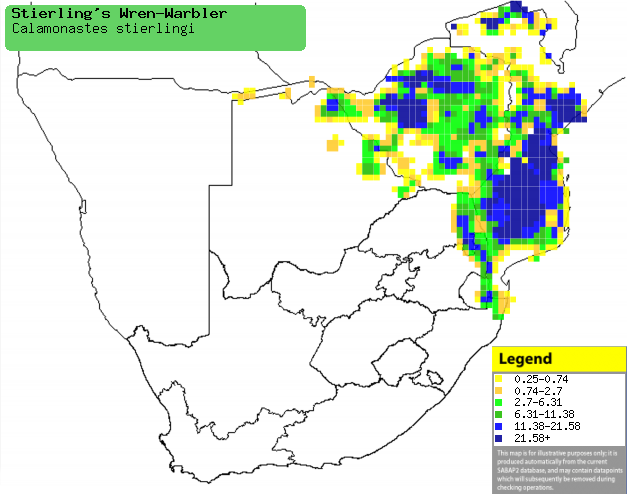|
Calamonastes stierlingi (Stierling's
wren-warbler, Stierlings barred warbler)
Stierlingse sanger [Afrikaans]; Xingede [Tsonga]; Kleine
Savannezanger [Dutch]; Camaroptère de Stierling [French];
Stierling-bindensänger [German]; Felosa de Stierling [Portuguese]
Life
> Eukaryotes >
Opisthokonta
> Metazoa (animals) >
Bilateria >
Deuterostomia > Chordata >
Craniata > Vertebrata (vertebrates) > Gnathostomata (jawed
vertebrates) > Teleostomi (teleost fish) > Osteichthyes (bony fish) > Class:
Sarcopterygii (lobe-finned
fish) > Stegocephalia (terrestrial
vertebrates) > Tetrapoda
(four-legged vertebrates) > Reptiliomorpha > Amniota >
Reptilia (reptiles) >
Romeriida > Diapsida > Archosauromorpha > Archosauria >
Dinosauria
(dinosaurs) > Saurischia > Theropoda (bipedal predatory dinosaurs) >
Coelurosauria > Maniraptora > Aves
(birds) >
Order: Passeriformes > Family: Cisticolidae
> Genus: Calamonastes
Distribution and habitat
It occurs from Tanzania to Mozambique, Zimbabwe, South
Africa and the Caprivi Strip. It is fairly common in southern Africa, preferring
dense areas of undergrowth in broad-leaved woodland with miombo (Brachystegia)
and Zambezi teak (Baikiaea plurijuga). It also occupies Acacia
woodland, and it may even move into suburban gardens in Zimbabwe.
|
 |
|
Distribution of Stierling's wren-warbler in
southern Africa, based on statistical smoothing of the records from
first SA Bird Atlas Project (©
Animal Demography unit, University of
Cape Town; smoothing by Birgit Erni and Francesca Little). Colours range
from dark blue (most common) through to yellow (least common).
See here for the latest distribution
from the SABAP2. |
Food
It mainly eats insects, doing most of its foraging in the
foliage of trees and bushes, gleaning prey from leaves and stems.
Breeding
- The nest is ball-shaped with a side entrance, made of fine grass, felted
plant down and secured with spider web to the surrounding foliage. It is
typically placed in the mid canopy of a broad-leaved tree, such as Msasa (Brachystegia
spiciformis), Buffalo-thorn (Ziziphus mucronata) and Velvet
bushwillow (Combretum molle).
- Egg-laying season is from September-March, peaking from
October-December.
- It lays 2-4 white to light blue eggs, covered with tiny reddish brown
dots.
Threats
Not threatened.
References
-
Hockey PAR, Dean WRJ and Ryan PG 2005. Roberts
- Birds of southern Africa, VIIth ed. The Trustees of the John Voelcker
Bird Book Fund, Cape Town.
|
